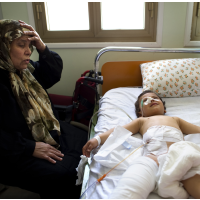While U.S. Drags Feet on Curtailment of Cluster Bombs, Their Use Goes Unabated in Yemen and Syria
 3-year-old girl was seriously injured victim of cluster bomb attack (photo: Odd Andersen, AFP/Getty Images)
3-year-old girl was seriously injured victim of cluster bomb attack (photo: Odd Andersen, AFP/Getty Images)
By Sewell Chan, New York Times
Cluster bombs, which have been used since World War II to kill and maim indiscriminately, were outlawed under an international treaty that was adopted in 2008.
Most of the world’s countries have signed the treaty, but not the United States and Russia, where many of the bombs were made. A report released Thursday in Geneva found that the weapons continued to be used with near impunity in the conflicts in Syria and Yemen.
In Syria, at least 13 kinds of cluster munitions — dropped from the air or launched from the ground — have been used since 2012, said the report, the seventh annual Cluster Munition Monitor (pdf) , which found “compelling evidence” that Russia had used the weapons since the start of its military intervention last September in support of Syria’s embattled government.
In Yemen, seven kinds of cluster munitions were used in 19 attacks from April 2015 to February of this year as part of the Saudi-led coalition’s fight against Shiite Houthi rebels, the report found. Saudi Arabia, which has not signed the treaty, has acknowledged using the munitions once, in April 2015. Most of the cluster bombs used in Yemen originated in three countries: the United States, Britain and Brazil.
The report also found “strong but unconfirmed evidence” that cluster munitions had been used in April during a brief skirmish in the contested Nagorno-Karabakh region between Armenia and Azerbaijan; both countries denied using them.
Except for a single 2009 strike in Yemen, the United States has not used cluster bombs since 2003, and has not budgeted funds to acquire new cluster munitions since 2007. A Defense Department policy requires that use of cluster munitions with a failure rate of greater than 1 percent be phased out by 2018. The policy also states that countries that receive such munitions from the United States may not use them in civilian areas, but the report cast doubt on whether that requirement has been met.
The report’s author, the Landmine and Cluster Munition Monitor, which provides research for the International Campaign to Ban Landmines and the Cluster Munition Coalition, did find signs of improvement in the United States.
In April, activists began regular protests outside the Providence, Rhode Island, headquarters of Textron, a maker of cluster munitions. In May, the Pentagon stopped delivering cluster munitions to Saudi Arabia. And in June, a provision to ban the transfer of such munitions to Saudi Arabia was nearly adopted by the House of Representatives, losing on a vote of 216-204.
This week, before the report’s release, Textron announced that it would stop making cluster munitions, noting that “the current political environment” made it hard to sell the weapons.
Mary Wareham, the advocacy director for the arms division at Human Rights Watch, who was involved in the report, cheered the decision, saying in a statement, “Textron was the last U.S. manufacturer of cluster munitions, so this decision now clears the path for the administration and Congress to work together to permanently end U.S. production, transfer and use of cluster munitions.”
Like its predecessor, however, President Barack Obama’s administration has shown little appetite for signing the treaty, which would be politically challenging, given the climate in Washington. In December, when the U.N. General Assembly for the first time adopted a resolution expressing support for the treaty banning the weapons, the United States abstained.
To date, the report found, 119 countries have agreed to the Convention on Cluster Munitions, and 100 of them are legally bound by all of its provisions. (The other countries have signed the treaty, but have not yet ratified it.) Under the convention, 29 countries have completed the destruction of nearly 1.4 million stockpiled munitions containing 172 million sub-munitions, or bomblets.
Germany, Italy, Japan, Mozambique and Sweden completed the destruction of their stockpiles last year, and France did so in June.
Next week, Obama will visit Laos as part of his final trip to Asia as president. Laos is the country most heavily contaminated by cluster bombs, which the United States dropped from 1964 to 1973, during the Vietnam War. Fourteen of the country’s 17 provinces, and a quarter of its villages, are thought to be contaminated with cluster bombs from that era, as are many parts of Cambodia and Vietnam.
To Learn More:
Cluster Munition Monitor 2016 (Cluster Munition Coalition) (pdf)
U.S. Cluster Bombs Used by Saudis in Yemen May Violate U.S. Law (by Rick Gladstone, New York Times)
U.S. “Concern” Over Yemen Crisis Belies Its Military Support of Saudi Coalition Bombing (by Noel Brinkerhoff, AllGov)
In an Overlooked War, Saudis Use U.S.-Made Weapons to Kill Civilians in Yemen (by Noel Brinkerhoff, AllGov)
Saudi Arabia Military Ignores Restrictions on Use of U.S.-Made Cluster Bombs Maiming Civilians in Yemen (by Steve Straehley, AllGov)
- Top Stories
- Unusual News
- Where is the Money Going?
- Controversies
- U.S. and the World
- Appointments and Resignations
- Latest News
- Musk and Trump Fire Members of Congress
- Trump Calls for Violent Street Demonstrations Against Himself
- Trump Changes Name of Republican Party
- The 2024 Election By the Numbers
- Bashar al-Assad—The Fall of a Rabid AntiSemite






Comments